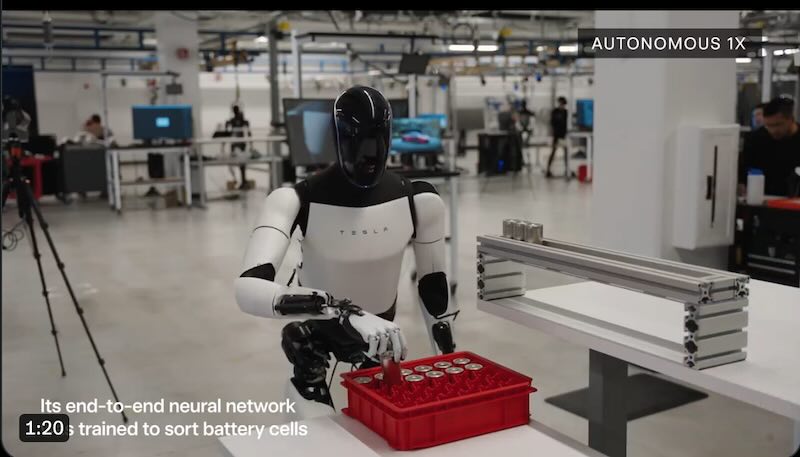Elon Musk’s teams have taken another big step toward unleashing a real-world workforce of humanoid helper robots. In a fresh video update demonstrating the latest capabilities of its Optimus prototype, Tesla Inc. revealed the machine is now deftly performing tasks like sorting battery cells and fixing its own errors.
The new footage, outlined by Optimus Engineering Director Milan Kovac, shows the robot seamlessly picking up individual 4680 battery cells from a conveyor belt and meticulously placing them in trays using its gripping hands. While the motions appear somewhat sluggish, Milan Kovac highlighted Optimus’s increasing reliability in executing the choreography from start to finish.
Tesla bot also illustrated an ability to self-correct when mistakes occur – spotting dropped cells through its array of sensors and cameras, then bending over to retrieve them from the floor. It’s an impressive display of the advanced visual intelligence and dexterity Tesla AI is baking into its robotics platform.
Robots in the Real World
According to Milan Kovac, these new skills are the result of deploying Optimus units into actual factory testbeds and production lines. Multiple robots are now undergoing daily refinement at genuine workstations while also traversing office settings without incident.
To pull off these real-world capabilities, Tesla Optimus prototypes rely on an end-to-end neural network model running entirely on their internal compute hardware derived from Tesla’s FSD vehicle computers. This AI brain consumes video feeds and sensor data from the robot to directly generate precise joint and grip sequences for handling objects and navigating.
Critically, a single neural net is designed to handle multiple distinct tasks by incorporating diverse training data. This unified approach aims to maximize the robots’ versatility and functionality right out of the box.
The Road to Scalable Humanoid Robots
Of course, Tesla still has major milestones ahead before realizing Musk’s vision of a scalable, mass-producible humanoid robot platform. Milan Kovac cited priorities like boosting Optimus’s speed, mobility over challenging terrain, and training techniques to account for minor hardware variances across assembled bots.
February 25, GearMusk has post Optimus robot walks faster, so what upgrades did Tesla make to enable Optimus’ peppier pace? Kovac cites improvements to the robot’s vestibular system, foot trajectory planning, and ground contact logic. These enhancements provide more stability and confidence, resulting in faster straight line walking. Turning motions are also more controlled now.
The tangible demos of practical robotics skills have certainly raised the stakes in Tesla’s unorthodox pursuit of an autonomous robot workforce. One that could theoretically be deployed for everything from mundane factory duties to household assistance if fully realized.
While Musk’s robotic ambitions have courted plenty of skepticism in the past, successfully operationalizing multitalented robots in dynamic real-world settings would be a watershed breakthrough in the push to scale multipurpose, general-purpose robotics beyond niche applications. Tesla appears increasingly determined to pull it off.
